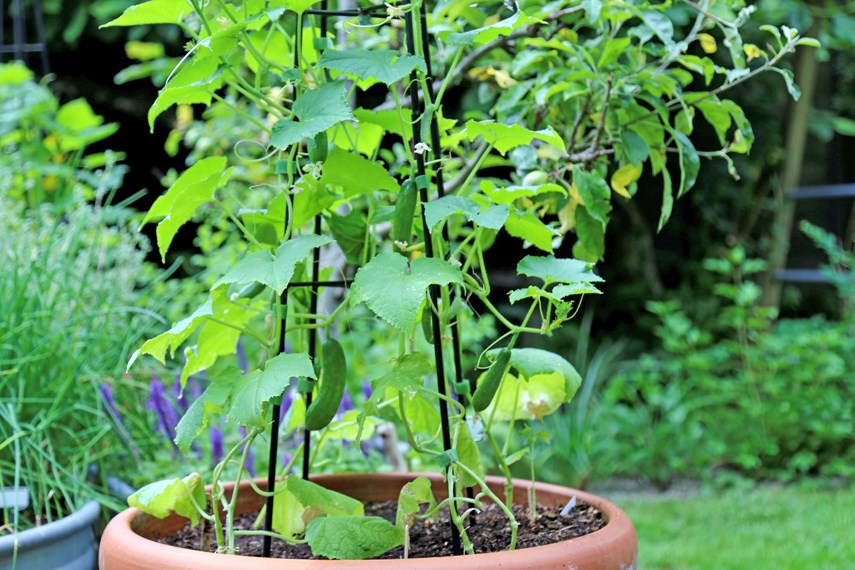Admittedly, it is uncomfortable writing about the privilege of growing food in my own garden, when 300 kilometres away, the world is on fire and an entire community burned to the ground in a matter of hours. The lesson perhaps is one of resilience, reflection, responsibility, and adaptation. Nature is wielding her iron fist, warning us to take better care of our planet and of each other.
These blistering hot days were tragic for many families, and perilous for food security. In our home garden, peas shrivelled to a crisp, anything that could bolt did, watercress cooked like soup in its pond, bush beans burned, and berry bushes shed buckets of unripe fruit. It was unmanageable, untameable heat, not drought, that wrought havoc.
Which plants fared the best? Most squash and some tomato varieties managed with pampering, but the cucumbers survived with little intervention. Cucumbers may be 95 per cent water, but they are 100 per cent cool. Densely nutritious, delicious and sleek, they are also clever. Because of their low profile, high water content and highly evolved protective skin, and because water does not absorb heat as easily or quickly as does the air, cucumbers can remain cool, calm and collected for an impressively long time, while less well-designed fruit and vegetables wither. This is no doubt, the root of the saying 'cool as a cucumber.’
Cucumbers are among my favourite foods to grow. They are resilient, resource-efficient, and do not demand too much space when grown vertically. Heat waves notwithstanding, our north shore damp, rain, and wet squidgy soil can wreak havoc on low hanging fruit and vegetables, so "resilient" and "trellisable" can make the difference between success and failure.
It isn’t a stretch to say that our Artist Gherkin cucumbers grew from infancy to adulthood during the span of one very hot week. Running a close second would be the Persian Green Fingers, followed by heirloom Lemons. I have found that the best way to grow cucumbers is up a trellis, a four-legged umbrella type that can double or quadruple yield. These adjustable trellises provide up to two metres of height for cucumber vines to ascend quickly, building their own shade cloth as they go.
I plant eight plants per trellis, which seems excessive, but they sort themselves out beautifully, as plants tend to do naturally. We end up with an abundance of healthy plants and gorgeous cucumbers straight through to mid October. Trellising cukes and small vining squash in columns, on flats or on twine, is a great way to optimize space in a small garden, raised bed or planter pot, or up against a sunny fence or building.
I grow from seed, in small pots, two plants per pot and then sink those plants as a unit, ‘gently’ astride each of the four uprights. They need a bit of guidance at the outset, which I oblige with soft green Velcro garden tape. Garden twine, I find, can cut through tender vines under weight or in a strong breeze.
In extremely hot weather, raised bed soil acts like a heat sink, which can adversely affect cucumbers and other vegetables (cukes are fruits, botanically speaking) but trellising provides distance from radiant heat, keeping cucumbers slightly cooler and also accessible to cooling breezes. Wet leaves dry more quickly on trellises than on the ground, which can help prevent downy mildew.
I share my cucumbers with my neighbours and friends, and with passers by whom I hope to encourage to start a food garden. I pickle and preserve them, add them to sandwiches, make gorgeous summer salads, make tiny edible appetizer cups, make cold soups and gazpacho, use their lovely peel to flavour cocktails, and enjoy them fresh-picked. Our tiny wee neighbours are learning to love vegetables by eating cucumbers and tomatoes straight off our vines. What’s not to love?
Growing food at home is a climate-positive act of hope and resilience. It isn’t too late to grow cucumbers, and to make new friends over the hedge or across the street. Garden centres still have seedlings, and the soil temperature is optimal for germination (15-30°C). Choose a small fruit variety and harvest frequently to encourage productivity.
Laura Marie Neubert is a West Vancouver-based urban permaculture designer. Follow her on Instagram @upfrontandbeautiful, learn more about permaculture by visiting her Upfront & Beautiful website or email your questions to her here.
For a taste of permaculture, click on the YouTube link below:


